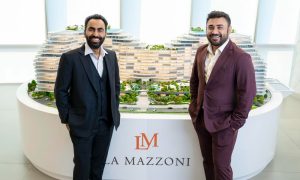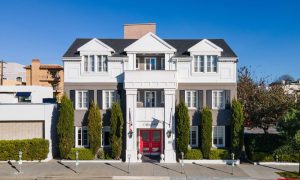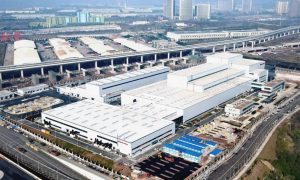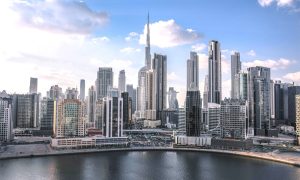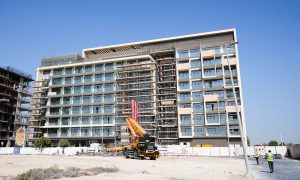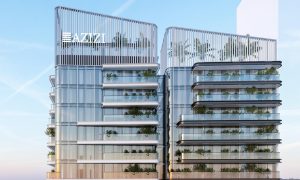On site: Serenia Residences on Palm Jumeirah, Dubai
Big Project ME visits the Serenia Residences on Palm Jumeirah with GAJ, to hear how having the right contractor can make all the difference to a project
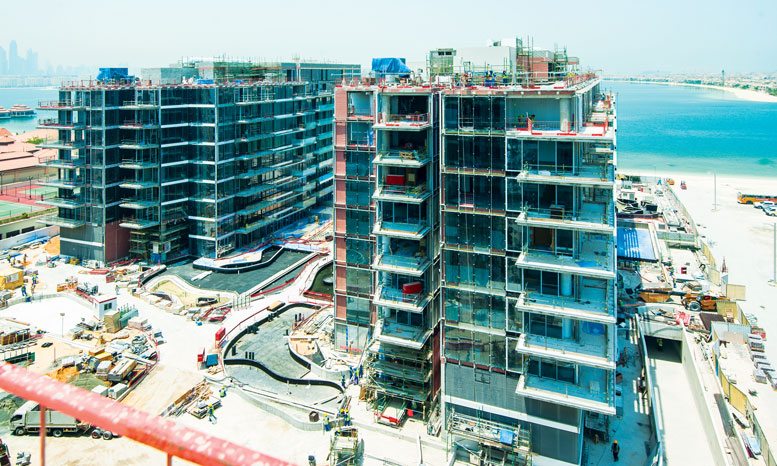
On the must-do list of any first-time visitor to Dubai is a drive down the Palm Jumeriah crescent, the strip of land that is home to some of the city’s most exclusive and extravagant hotels and resorts. However, they aren’t what visitors come to see. Rather, it’s the views that catch the eye, with the towers of Dubai Marina and Sheikh Zayed Road stretching across the horizon on one side, while the Arabian Gulf gleams on the other.
It’s this view that prompted Dubai developer Palma Holding to build its first residential project on the Palm. Situated on the furthest section of the eastern crescent, Serenia Residences overlooks the Marina on one side and the Burj Al Arab on the other. The development aims to provide residents with luxury homes that combine influences from the natural environment with high-end finishes and comforts.
Designed around a central space, the project consists of three buildings of nine floors each, plus basement and ground floor. In total, there are 250 apartments in the project, including three large penthouses on the rooftop of each building. When Big Project ME visited the project, structural work on the buildings was long finished, having been completed in December 2016, while cladding and façade work was also well underway on the exteriors.
In pictures: Serenia Residences on Dubai’s Palm Jumeirah under construction
With main contractor Khansaheb leading the way, interior works such as MEP and HVAC are ongoing. Built on a plot area of 21,108sqm and bordered by ongoing construction work and a fully operational hotel, the Serenia Residences project presented several challenges to the project team, says Jason Burnside, partner at Godwin Austen Johnson (GAJ), the lead consultant for the project.
One of the first challenges faced was to work within the parameters set by the conceptual design laid out by architect Hazel Wong, he explains.
“We took the project over from the concept stage. The client came to us at the time, looking to improve the efficiency of the apartment layouts, change the number of apartments and so on. The team started to get involved at that stage and we really looked to optimise the views, as it’s a fantastic site with views in both directions.
“The original architecture was set, in terms of the skin and shape of the building. What we needed to then do was decide where to put the best units, to maximise the returns for the client. We then had to look at the details of the building,” he adds, pointing out that there are sliding screens, floor-to-ceiling windows and big balconies across the units, to maximise the views for residents.
‘We looked to create spacious apartments with all the rooms working to a module that would then work with the façade system designed. The client had no real requirements, other than that we gave him the best apartments possible, as per the skin that was already previously defined.”
While the buildings have a total of 250 apartments, there are differences between them, adds Sunil Jasuja, senior associate at GAJ and the project leader of the GAJ Site Team. He reveals that one full building, known as the Penthouse Building, has half-floor penthouses all the way through.
“In that building – which we call Building B – more than half the floorplate is one apartment, stacked up through the seventh and eighth floors. The whole plot is divided by three towers, but the basement spans the entire plot.”
In pictures: Serenia Residences on Dubai’s Palm Jumeirah under construction
Although the buildings are separate entities, Burnside explains that the basement level covers the entire site, providing the development with underground parking and space for utilities and other necessities.
“The benefit of having everything connected to the basement is that it allowed us the maximum amount of podium space. The shape of the three buildings creates a central courtyard that is oriented towards the beach. There are apartments that will overlook the central landscaped area, while the pool is next to the beach and the water. It was crucial to get everything down into the basement if we possibly could, thus making sure that the ground floor was completely accessible to the owners, and that the central space was the anchor for all these buildings to face.”
However, the challenges around the project don’t end there. While the design of the project is certainly well thought-out and planned, the layout presented the project team with its most significant challenge.
“It’s a very tight fit,” says Burnside. “In terms of the permitted GFA that is available, trying to work that back to 250 apartments was a challenge. I would say that taking that through to where we are now, which is construction, [was our biggest challenge]. There’s no spare space on the site, it’s been very well developed. The site offices are right up against the boundary because the buildings themselves are pushing right to the envelope,” he explains, adding that the maximum GFA the team could create was 45,000sqm.
With the built-up area coming in at 71,300sqm, the size of the Serenia Residences project also created logistical challenges for the team. Both Jasuja and Burnside acknowledge that the hardest part of the project was the initial excavation of the site. Given the tightness of the site, with an operational hotel next door and another construction site on the other side, the contractor had little room to manoeuvre.
“We have a full basement, so it was a big logistical challenge for the contractor,” says Jasuja. “The neighbouring plot, although it’s empty, wasn’t available. The contractor couldn’t broker a deal with the landlord over there. Furthermore, the site road is the main access point for the crescent. That was blocked by Nakheel for six months as they were doing roadworks on it. Everything had to go through the front, so it was a real challenge.”
Therefore, in order to get the job finished in time, getting the right main contractor on board was crucial, both say. As lead consultants, the first requirement they had was that a grade A contractor needed to lead the project. With such an ambitious build and timeframe, they needed to make sure that the management structure and company they were dealing with were at the level required.
“Khansaheb won it because of a combination of their approach to the project and the confidence with which they dealt with the client during the tender and negotiation phase. Also, they were competitive pricewise,” Burnside says.
“It was a competitive tender. We went to all the grade A contractors, like the client wished. A couple of them were ruled out just on the timescale. One of the contractors said that they couldn’t do it in the timeframe we wanted, they wanted more time, and they were straight out of contention,” adds Jasuja, illustrating just how stringent the selection process was.
In pictures: Serenia Residences on Dubai’s Palm Jumeirah under construction
Burnside adds that it was essential to have a contractor with experience on projects of this nature and that had worked with the authorities previously.
“We rely on them heavily, on their ability to have the right management structure in place to allow materials to come to site. It’s quite a trip to get here, so getting around to here and managing the concrete pours, for example, can be quite critical. To some extent, that’s beyond our expertise. Of course we can offer them assistance, but really we rely on them heavily to deliver that expertise.
“And they’re used to it, they’ve done it before. In fact, Khansaheb had just completed another project in the area, so they were very familiar with the authority procedures, the timeframes to get approvals and those kinds of things. For us and the client, it was a massive reassurance to be dealing with someone who had just come off a project in the area.”
In fact, Jasuja relays an example of how familiar the contractor is with the area, pointing out that although the site has a night permit that only allows operations until midnight, Khansaheb’s relationship with the neighbouring hotel management has allowed them to obtain a no objection letter from them to allow work to run until 2am, from a start of 6am.
On a smaller scale, Jasuja points out that the project team had to also deal with day-to-day challenges such as the groundwater. Given the location and nature of the soil, this was not an unexpected challenge, but he makes the point that constant planning and vigilance was required to keep it under control.
When it comes to sustainability, the project isn’t aiming for specific green certifications, the men from GAJ reveal, but add that they were told to make sure the buildings were compliant with Dubai Municipality and Nakheel’s green regulations.
Where Khansaheb has taken the lead has been with the collaboration and planning for the project, they say. While the project was a standard build, it has used BIM and programmes like AutoCAD in the design and engineering phases. This has helped immensely with the planning and clash-detection for the project, Burnside says.
“The project had already been started in AutoCAD, so we just continued to work with that. However, we do use BIM when we have to, and it’s something that’s occurred naturally on this project. For a project like this, when the space is so tight, we needed to use BIM to coordinate and make sure things fit within the available space.
“Contractors are preferring to use BIM on projects now because they can do a lot more test fitting, laying out of pipework, ductwork and checking for clashes. On this project, given the timeframe and tightness of space, I’m sure it’s something Khansaheb considered using prior to coming on board. Logistically, it’s needed, and ultimately it affects them and makes them more efficient overall.”
In pictures: Serenia Residences on Dubai’s Palm Jumeirah under construction
Other than that, he adds that GAJ was careful not to include too many systems that would impede the pace of the project.
“We needed to deliver systems that we knew would not add additional time. We don’t need to create an engineering marvel, when in fact it is slab decks and columns being used to create a very clear façade.”
Jasuja chimes in to add that PT slabs were used as floor slabs, with slip forms and precast staircases also incorporated into the build.
“Precast staircases weren’t in our design, but the contractor proposed them for speed. It was nothing out of the ordinary, but we did it to assist the contractor, so as to meet the timeframe. In the initial stages, we considered having all the columns as precast, but it didn’t work out, considering the finishes we had to have. Because of the quality that we’re trying to achieve, it wasn’t possible.”
This flexibility and communication is also part of the reason Khansaheb was brought on board, Burnside says. Having worked on the Mall of the Emirates extension project, he says both GAJ and the client were confident that there would be a synergy between the tight site, the logistics and the management.
“If they’re not all working together with the consultant, it’s very difficult to achieve projects on time, especially on sites with tight timeframes. That was part of the decision-making process we had with the client. We said that they’re showing the right attitude and the right approach for the project, and that’s why you should be working with grade A contractors on projects like this,” he asserts.
This was also extended to the management of the site’s workers, he says. At peak, the project had 2,100 workers on-site, while at present they’re still operating with 1,650 workers. Despite these figures, GAJ say 4.5 million man hours have been achieved on the project, from August 2016 through to May 2017, without any lost time to injury.
“Khansaheb have been superb. They’re very conscious. As a practice, we’re very tight on that and normally we’d be going to site and picking up on things. But they are there and ahead of us. They’re very tight on that front. It’s a restricted site and safety is very much front and centre,” Burnside praises.
“We have very high standards for safety at GAJ,” adds Jasuja. “But Khansaheb has not given us any chances of complaining. They’ve been very proactive, and they have very high standards for safety.”
In pictures: Serenia Residences on Dubai’s Palm Jumeirah under construction
Project Name: Serenia Residences
Developer: Palma Residences
Owner: Serenia Residences Limited
Main Contractor: Khansaheb Civil Engineering
Lead Consultant: Godwin Austen Johnson
Number of Storeys: B + G + 9
Number of Units: 250
Total Built-up Area: 71,300sqm
Gross Floor Area: 45,000sqm
Plot Area: 21,108sqm
Expected Completion: October 2017
GAJ Site Team
• Sunil Jasuja (Senior Associate) – project leader
• Manikandan Muthumanickam (Senior Architect)
• Karthikeyan Govindasamy (Senior Engineer)
• Tariq Ullah Khan (Document Controller)








